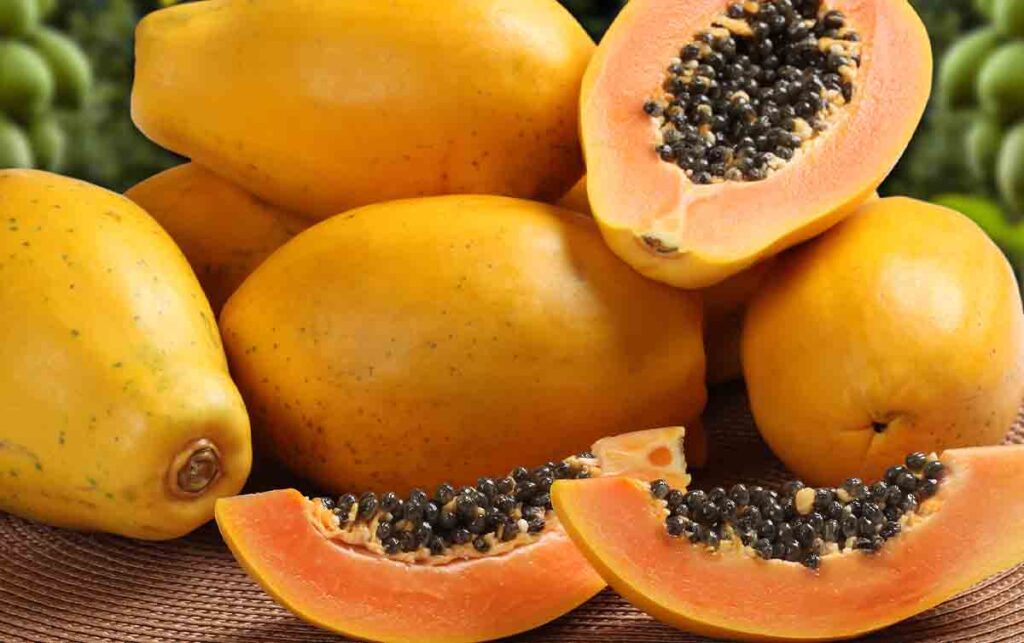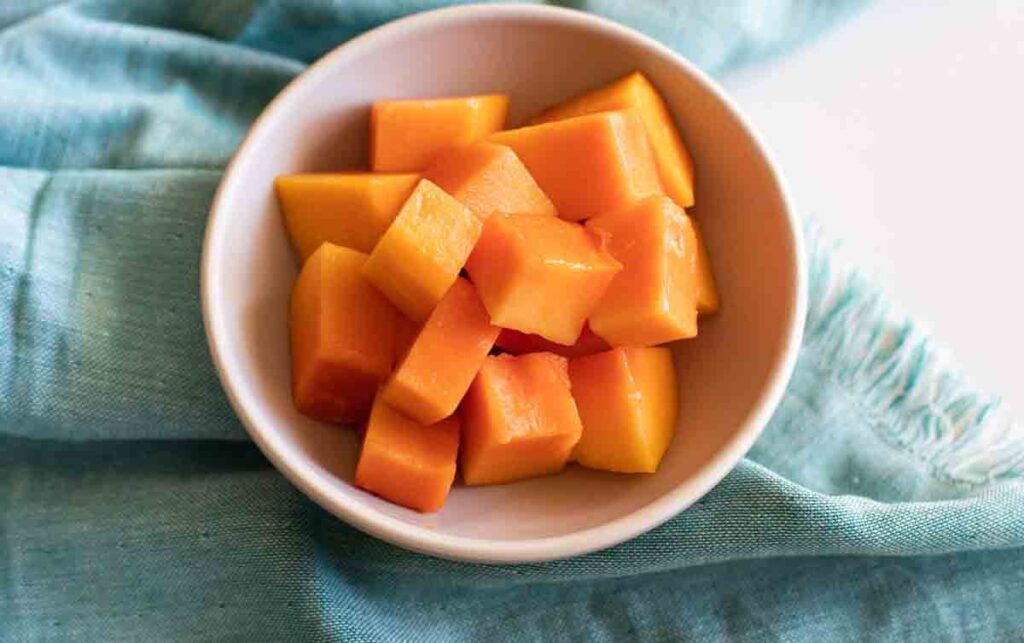Papaya is a wonderful fruit full of nutrients, vitamins, antioxidants, and enzymes. It contains high amounts of vitamin C, folate, and fiber. Its nutritional value comes from its high content of beta-carotene, lutein, lycopene, and zeaxanthin. These carotenoids act as powerful natural antioxidants, helping to protect the body from free radicals that can damage cells. Papaya also contains manganese, copper, and iron. Manganese is involved in many enzyme systems in the body, including those related to detoxification, carbohydrate metabolism, and collagen formation. Copper helps keep blood vessels clean and healthy, while iron assists in oxygen transport throughout the body.
Papayas are rich in vitamin A and vitamin C. Vitamin A is necessary for muscle maintenance and healing. Most people know that vitamin C is good for immunity and wound healing; however, scientists have recently discovered that it may also play an important role in brain function. Vitamin C aids the immune system by increasing white blood cell count and is responsible for the production of antibodies. Many fruits and vegetables, including papaya, contain folic acid, often referred to as B9. It is a water-soluble B vitamin found naturally in green leafy vegetables, citrus fruits, and beans. Folic acid is especially beneficial for pregnant women, as it lowers the risk of birth defects, such as neural tube defects, when taken during pregnancy.
Papaya is also a good source of dietary fiber. Fiber adds bulk to food and helps us feel fuller for longer. It helps control cholesterol levels, regulates bowel movements, and keeps the digestive tract healthy. In addition, fiber reduces the absorption of glucose and insulin, both of which contribute to the regulation of blood sugar levels. Fiber also promotes weight loss by keeping the stomach full, which helps reduce overeating.
How Much and How Often To Breastfeed?
Papaya is a tropical fruit rich in vitamin A, vitamin C, fiber, and antioxidants. It contains enzymes that aid in digestion, making it great for digestive health. Most people enjoy eating papayas raw, but they can also be cooked or blended into smoothies. There are many different cultivars of papaya; however, the two most popular are Carica papaya (paw-paw) and Malus domestica (apple).
Papaya fruit contains high amounts of vitamin C and beta-carotene.
Papaya provides the body with lots of nutrition, vitamins, and nutrients. One of its key health benefits is its ability to help protect the immune system.
Guide to Using Rosemary Water for Hair
Papaya fiber is rich in vitamins and minerals.
The fiber content of papaya helps lower cholesterol levels and reduce the risk of colon cancer. Other nutritional components include vitamins A, B, and C; manganese; zinc; copper; folate; and iron.
It reduces the risk of cancer.
Studies show that people who eat about two cups of chopped fresh fruits and vegetables each day have half the likelihood of developing certain types of cancer compared to those who do not.
It helps prevent depression.
Papaya contains the amino acid L-tryptophan, which is thought to help relieve depression. Research suggests that eating foods rich in tryptophan may have antidepressant effects.
Skin Care Routine for Oily Skin
It’s good for your heart.
One cup of raw papaya per day can help prevent cardiovascular disease. Additionally, research shows that papain, an enzyme in papayas that breaks down protein, reduces blood pressure.
It helps you feel full.
Papaya contains the enzyme chymopapain, which digests food particles in the stomach. Once digestion begins, hunger pangs disappear, helping you feel fuller for longer.
It helps stretch out your meal.
You don’t need to wait until after dinner to enjoy some papaya. Adding diced papaya to a salad makes it easier to finish your meal.
Risks of papaya
Papaya contains latex, which may cause an allergic reaction in some people. It also contains cyanide, which is toxic if eaten in sufficient quantities. Additionally, papaya contains solanine, which can damage red blood cells. A high-protein diet may increase the risk of urinary tract infections (UTIs), caused by bacteria in the urine. Symptoms of UTIs include frequent urination, burning while urinating, pain in the lower back and abdomen, pain in the groin area, cloudy urine, painful urination, and fever. If left untreated, UTIs may result in kidney failure.
How to eat papaya
Papayas aren’t just fruits; they’re fruits’ fruits! An interesting fact about these tropical beauties is that they have the highest vitamin C content of any other fruit and contain high levels of beta-carotene, folate, lutein, and lycopene, making them a great addition to your diet. Their sweet flavor makes them easy to enjoy, whether eaten plain or used in salads and smoothies.
Papayas are one of the best foods for gut health. They have high levels of vitamin C, folate, fiber, and lutein, all essential for proper digestion. Not only do they aid digestion, but papayas also help with detoxification and liver function.
The easiest way to consume papayas is raw. You can simply cut them open and scoop out the flesh. However, there are many ways to prepare papayas. One of my favorite methods is making fruit salad by mixing chopped ripe papaya with bananas, strawberries, oranges, kiwi, apples, pineapple chunks, and peaches. This makes for a delicious snack or dessert.
Another great way to enjoy fresh papaya is to use it as a topping for salads or a side dish with grilled chicken or fish. I love mixing pieces of fresh papaya with tomatoes and onions to create a colorful dish.
Easy Remedies for Glowing Skin
Papayas can also be used in stir fry, soups, smoothies, and even ice cream!
Here are some recipes using papaya:
Raw Papaya Salad
- ½ cup raw papaya (you won’t taste the seeds)
- ¼ cup red peppers, chopped
- ¼ cup celery, chopped
- ⅓ cup carrots, shredded
- 1 tablespoon extra virgin olive oil
- Salt and pepper to taste
Relief for Gassy Infants: Newborn gas Remedies
In a bowl, combine the ingredients and let sit at room temperature for 2 hours before serving.
Blend Ingredients: Place the ingredients in a blender with ½ cup water and ¼ teaspoon freshly squeezed lemon juice. Blend until smooth. Add salt and pepper to taste. Serve over baby spinach leaves.
Benefits Face-Steaming and How to Do It at Home




